ST EDMUND THE KING, NORTHWOOD HILLS
ARCHIVE SEP 2003-AUG 2004
The articles below are taken from my monthly columns in St Edmund's Church parish magazine ("The King"), which includes full details of my organ voluntaries for that month.
FROM THE CONSOLE - AUGUST 2004
NO COLUMN
FROM THE CONSOLE - JULY 2004
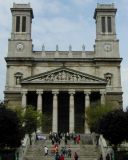
Click to enlarge
I stumbled across the Parisian church of St Vincent de Paul quite by accident while walking towards the Gare du Nord to catch the Eurostar home after a recent break in the French capital.
St Vincent de Paul was born in the Gascony region of France around 1580. He was seized by pirates on a journey from Marseille to Narbonne and was sold as a slave in Tunisia until he managed to escape and return to France. He worked as a priest and chaplain and later founded several charitable organisations, notably the Daughters of Charity. He died in Paris in 1660 and was canonised in 1737. The church itself dates from the nineteenth century and possesses a notable frieze by the French Neo-Classical painter Hippolyte Flandrin.
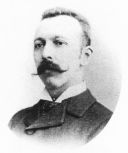
Click to enlarge
Probably the most famous organist at St Vincent de Paul was Léon Boellmann. He was born in Ensisheim in Upper Alsace in 1862 and studied at the Ecole Niedermayer in Paris with Gigout (of "Toccata" fame) and won the prestigious Grand Prix d'Orgue. He was appointed Titulaire at St Vincent de Paul in 1881 and held the post until his untimely death in 1897 aged just 35. He is best-known for the Toccata from his Suite Gothique, which dates from 1895. One of St Edmund's choir recently told me that this piece reminded her of "The Adams Family" - judge for yourself on July 11th! Boellmann's music inspired may of the composers of the twentieth century French School such as Widor and Vierne.
The voluntaries for July 4th have been specially chosen by Father Bruce for his celebration of 25 years in the priesthood and I extend my congratulations on this special occasion. "From the Console" will be taking a break next month and will be back in September.
Jul 4th
Prelude - Pavane - G.Fauré (1845-1924)
Postlude - Prelude to a Te Deum - M-A Charpentier (1643-1704)
Jul 11th
Prelude - Prière à Notre Dame ("Suite Gothique") - L.Boellmann (1862-1897)
Postlude - Toccata ("Suite Gothique") - L.Boellmann
Jul 18th
Prelude - Praeludium Pedaliter - J.Sweelinck (1562-1621)
Postlude - Prelude on "Lobe Den Herren" - M.Reger (1873-1916)
Jul 25th
Prelude - Lyric Melody - C.Armstrong Gibbs (1889-1960)
Postlude - Jubilate Deo - C.Armstrong Gibbs
Aug 1st
Prelude - Tierce en Taille ("Mass for the Parishes") - F.Couperin (1668-1733)
Postlude - Dialogue et Trio ("Mass for the Parishes") - F.Couperin
Aug 22nd
Prelude - Promenade Sentimentale - V.Cosma (b.1940)
Postlude - Toccata (Symphony No 5) - C.Widor (1844-1937)
Aug 29th
Prelude - Largo ("Xerses") - G.F.Handel (1685-1759)
Postlude - Praise The Lord O My Soul - S.Karg-Elert (1877-1933)
FROM THE CONSOLE - JUNE 2004
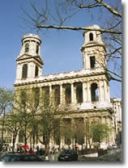
Click to enlarge
During a recent trip to Paris I was fortunate to visit several churches with connections to famous French composers. One such is St Sulpice in the left-bank Latin Quarter. St.Sulpice was a seventh century bishop of Bourges in central France. His concern for the poor and the sick left him to found the first hospital in the city. He spent his final years as a monk in the Abbey which he founded and died aged 77.
There has been a church on the present site for almost a thousand years although the current building dates from the seventeenth century. It took six architects over a century to build and it is still not complete as one of the towers is five metres shorter than the other!
The organ in St Sulpice was built by Cliquot in 1781 and was substantially rebuilt by the great French organ builder Aristide Cavaillé-Coll in 1857. In 1863 Louis Lefébure-Wély was appointed organist and was succeeded seven years later by Charles Widor. Although not officially appointed as titulaire, Widor nevertheless held the post for 63 years. He was replaced in 1933 by Marcel Dupré, who held the post for 38 years; he died on Pentecost Sunday in 1971 after playing for the morning services.
Jun 6th
Prelude - Symphony No 5 (Fourth Movement) - C.Widor (1844-1937)
Postlude - Fantasia in C minor - J.S.Bach (1685-1750)
Jun 13th
Prelude - Morning ("Peer Gynt") - E.Grieg (1843-1907)
Postlude - Grand March from "Aida" - G.Verdi (1813-1901)
Jun 20th
Prelude - The Londonderry Air - Trad, arr H.Geehl (1881-1961)
Postlude - Prelude to a Te Deum - M-A.Charpentier (1643-1704)
Jun 27th
Prelude - Andante - A.Scriabin (1872-1914)
Postlude - Sortie in E Flat - L.Lefébure-Wély (1817-1869)
FROM THE CONSOLE - MAY 2004
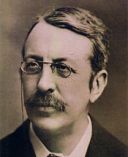
Click to enlarge
Born in 1852, Charles Stanford was the son of a Dublin lawyer. He studied Classics at Queens College Cambridge although he spent more time on music and became organist at Trinity College in his third year and founded CUMS - the Cambridge University Musical Society. After graduating, Stanford went to study in Germany and his music shows many Germanic traits of composers such as Brahms. Stanford revived the English choral tradition with his anthems and settings including six settings of the Magnificat and Nunc Dimittis. The setting in C Major is to be sung at St Edmund's at the Pentecost Evensong on May 30th and you can listen to the Magnificat on the internet here. His Postlude in D Minor, which I shall be playing at this Evensong, is taken from the second set of “Six Short Preludes and Postludes” and dates from 1908. Stanford held simultaneously the posts of Professor of Music at Cambridge University and Professor of Music at the Royal College of Music for nearly forty years and his students included Frank Bridge, Gustav Holst, Herbert Howells, John Ireland and Vaughan Williams. Stanford was knighted in 1902 and spent most of his time in London at 56 Hornton Street in Kensington and this is commemorated with an English Heritage blue plaque. He died in 1924 and is buried next to Purcell in Westminster Abbey.
May 2nd
Prelude - Sheep May Safely Graze - J.S.Bach (1685-1750)
Postlude - Voluntary No 1 in C - William Boyce (1711-1779)
May 9th
Prelude - Chanson de Matin - E.Elgar (1857-1934)
Postlude - Voluntary No 2 in A Minor - William Boyce
May 16th
Prelude - Prelude on "Rhosymedre" - R.Vaughan Williams (1872-1958)
Postlude - Prelude on "Hyfrydol" - R.Vaughan Williams
May 23rd
Prelude - Prière du Christ Montant Vers Son Père (L'Ascension) - O.Messiaen (1908-1992)
Postlude - Final & Marche - L.Boellmann (1862-1897)
May 30th (10am)
Prelude - Majestié du Christ Demandant Sa Gloire à Son Père (L'Ascension) - O.Messiaen
Postlude - Songs of Praise - R.Prizeman (b.1952)
May 30th (Evensong)
Prelude - Psalm Prelude (Set 1, No 1) - H.Howells (1892-1983)
Postlude - Postlude in D Minor - C.Stanford (1852-1924)
FROM THE CONSOLE - APRIL 2004
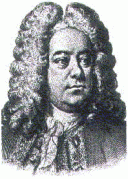
Click to enlarge
Did you know that the great composer George Frederick Handel (pictured above) once lived just six miles from St Edmund's Church? Cannons was a grand palace (on the site of the present North London Collegiate School near Stanmore) built around the turn of the seventeenth century by Sir Thomas Lake, Chancellor to James I. The palace was subsequently inherited by Lake's great-granddaughter who later married John Bridges. Bridges became Duke of Chandos in 1717 and in the same year Handel joined the Cannons household as Resident Composer and during his three-year employment there composed the 11 Chandos Anthems, the oratorio "Esther" and the opera "Acis and Galatea", which was first performed in the palace gardens.
The Water Music was composed for a royal procession down the River Thames by King George I on July 17th 1717. The royal party travelled by barge from Whitehall to Chelsea, where they disembarked for supper, returning at 3am. The orchestra followed in a second barge containing fifty players. Speaking of the music, one contemporary noted, "His Majesty approved of it so greatly that he caused it to be repeated three times in all, although each performance lasted an hour - namely twice before and once after supper".
In 1723, Handel moved into a house in Brook Street (just off New Bond Street) which was to be his home until his death. It has now been turned into a museum dedicated to the composer (www.handelhouse.org). Incidentally, Jimmy Hendrix lived next door to this house in the late sixties and this property now forms part of the Handel House Museum.
George Frederick Handel died in London on April 14th 1759 aged 74. He was born in the same year as J.S.Bach (1685) but outlived him by nine years.
Apr 4th (Palm Sunday)
Prelude - Palm Sunday Processional - C.Tambling (b.1964)
Postlude - Ciacona in D Minor - J.Pachelbel (1653-1707)
Apr 11th (Easter Sunday)
Prelude - A Resurrection Prelude - James Patten (b.1936)
Postlude - Christ Ist Erstanden BWV 627 - J.S.Bach (1685-1750)
Apr 18th
Prelude - Air (Water Music) - G.F.Handel (1685-1759)
Postlude - Hornpipe (Water Music) - G.F.Handel
Apr 25th
Prelude - Nun Sei Willkommen Jesus Lieber Herr - Flor Peeters (1903-1986)
Postlude - Prelude and Fugue in D Minor - D.Buxtehude (1637-1707)
FROM THE CONSOLE - MARCH 2004
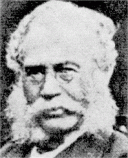
Click to enlarge
Back in October, I wrote the first of my layman's guide to the organ (still available online at www.mark-hammond.co.uk/edmusic.htm).
You may have wondered why there are different coloured stops on the organ at St Edmund's. Each stop is an individual voice in the organ (and St Edmund's organ possesses 37 speaking stops) and as well as a name has a number which refers to the length of its longest pipe. An 8' pipe is at standard concert pitch while a 4' pipe is one octave higher and a 2' pipe two octaves higher. Similarly a 16' is one octave lower than standard concert pitch. There are also special stops called mutations and mixtures which add colour and brilliance to the sound.
There are two types of pipe - flues (coloured white at St Edmund's) and reeds (coloured red). Flue pipes (such as flutes) have no moving parts other than the flowing air, while the reed pipes (such as clarinet and trumpet) have a vibrating tongue to produce the sound. The green coloured stops are couplers as discussed in my first layman's guide.
For further information, there is an excellent organ glossary on the Wicks Organ Company website. If you have any questions do come and ask!
Henry Smart was born on October 26th 1813. He initially studied Law but soon gave this up in favour of music. Following a five year spell as organist at Blackburn Parish Church he moved to London in 1836 where he held posts at St Phillip's (Regent St), St.Luke's (Old St) and St Pancras (Euston Rd). The majority of his compositional output was choral and organ music. For the last fifteen years of his life Smart was blind. He died in 1879 and is buried in Hampstead Cemetery. He has written several hymn tunes including Regent Square (Lights Abode, Celestial Salem), Heathland (God of Mercy, God of Grace) and Everton (Son of God, Eternal Saviour). He was also a renowned organ designer who was responsible for the organs in the town halls in Glasgow and Leeds.
Mar 7th
Prelude - Prelude in A - Henry Smart (1813-1879)
Postlude - Festive March In D - Henry Smart
Mar 14th
Prelude - Pavane - G.Faure (1845-1924)
Postlude - Fugue No.1 on BACH - R.Schumann (1810-1856)
Mar 21st
Prelude - Herlich Thut Mich Verlangen (Op.122, No.10) - J.Brahms (1833-1897)
Postlude - Toccata - E.Gigout (1844-1925)
Mar 28th (Passion Sunday)
Prelude - O Mensch, bewein' dein' Sunde gross - J.S.Bach (1685-1750)
Postlude - Trio Sonata No 5 (1st movement) BWV 529 - J.S.Bach
FROM THE CONSOLE - FEBRUARY 2004
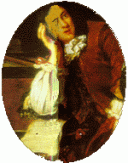
Click to enlarge
Here are the solutions to last month's crossword:
ACROSS
4 Rossetti; 9 Winchester; 10 Holst; 13 Christchurch; 14 Swell; 16 Sicilienne; 18 Messiaen; 20 Bede; 21 Trinity; 22 Corpus;
DOWN
1 Jubilo; 2 Christi; 3 Dulci; 5 Orgelbuchlein; 6 In; 7 Great; 8 Peterhouse; 11 Buxtehude (pictured above); 12 Albinoni; 14 Sulpice; 15 Highgate; 17 St Mary's; 19 Albi
February 1st
Prelude - Sicilienne - Maria Theresia von Paradis (1759-1824)
Postlude - Prelude and Fugue No 4 (BWV 556) - J.S.Bach (1685-1750)
February 8th
Prelude - Legende - Louis Vierne (1870-1937)
Postlude - Prelude and Fugue No 5 (BWV 557) - J.S.Bach (1685-1750)
February 15th
Prelude - Arabesque - Louis Vierne
Postlude - Prelude and Fugue No 6 (BWV 558) - J.S.Bach (1685-1750)
February 22nd
Prelude - Picardy - Alec Rowley (1892-1958)
Postlude - Prelude and Fugue No 7 (BWV 559) - J.S.Bach (1685-1750)
February 29th
Prelude - Eden - Betty Roe (b.1930)
Postlude - Prelude and Fugue No 8 (BWV 560) - J.S.Bach (1685-1750)
FROM THE CONSOLE - JANUARY 2004
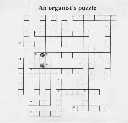
Click to enlarge
At the end of this festive season I would like to offer you something slightly different. The answers to this crossword have all appeared in my magazine column over the past year. Some of the clues are straightforward but some are rather more cryptic. If you need any help and have internet access, all of my past columns can be found on this page and on my archive page. The relevant month is indicated next to each clue.The solution will be published in the February magazine.
ACROSS
4 Poet who wrote "In The Bleak Midwinter" (8 Letters, Dec)
9 Cathedral whose organ originated from the 1851 Hyde Park Great Exhibition (10 Letters, Apr)
10 Composer of 4 Across (5 Letters, Dec)
13 11th Century Dorset Priory where I was started to learn the organ (12 Letters, Mar)
14 Section of the organ which is placed in an enclosed box to enable the sound to be made louder or softer (5 Letters, Oct)
16 Composition attributed to Maria Theresia von Paradis which sounds like a native of an Italian island (10 Letters, Feb)
18 Olivier ------, arguably the greatest organ composer since Bach (8 Letters, Apr)
20 Venerable Saint who was the author of the "Ecclesiastical History of the English People" and who has a Durham college named after him (4 Letters, Jun)
21 A Holy Threesome for which I try tin (7 Letters, Nov)
22 & 2 Down See 2 Down June feastday for which the Coventry Carol was originally written (6 + 7 Letters, Nov)
DOWN
1 See 6 Down
2 See 22 Across
3 See 6 Down
5 Name of J.S.Bach's "Little Organ Book" of 46 Chorale Preludes written for the liturgical year (13 Letters, Nov)
6 & 3 Down & 1 Down Famous Christmas Carol which first appeared in a 16th Century Finnish collection (2 + 5 + 6 Letters, Nov)
7 The main section of an organ (5 Letters, Oct)
8 Oldest of the Cambridge Colleges (10 Letters, May)
11 Bach is reputed to have walked 200 miles to hear this organist and composer (9 Letters, May)
12 Composer attributed to the famous Adagio in G Minor but actually composed by Giozotto (8 Letters, Jan)
14 St ------, Parisian church where Widor was organist for over 60 years, anagram of "cue slip" (7 Letters, Nov)
15 Where 4 Across is buried (8 Letters, Dec)
17 Church and stadium in Southampton (2 + 5 Letters, July)
19 Arrange Bail for this SW French city (4 Letters, Sep)
January 11th
Prelude - Chorale Prelude on "Stuttgart" - Flor Peeters (1903-1986)
Postlude - Prelude and Fugue No 1 (BWV 553) - J.S.Bach (1685-1750)
January 18th
Prelude - Chorale Prelude on "Dix" - Malcolm Archer
Postlude - Prelude and Fugue No 2 (BWV 554) - J.S.Bach (1685-1750)
January 25th
Prelude - Adagio (Symphony No 3) - C.Saint-Saens (1835-1921) (
Postlude - Prelude and Fugue No 3 (BWV 555) - J.S.Bach (1685-1750)
FROM THE CONSOLE - DECEMBER 2003
In the bleak midwinter, frosty wind made moan,
Earth stood hard as iron, water like a stone;
Snow had fallen, snow on snow, snow on snow,
In the bleak midwinter, long ago.
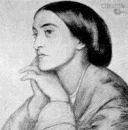
Click to enlarge
As organist of St Edmund's, I write a monthly magazine column outlining my forthcoming voluntaries and discussing a particular topic or composer.
In a poll of over 27,000 listeners carried out by Classic FM a couple of years ago, "In The Bleak Midwinter" was voted the nation's favourite Christmas carol, drawing more than twice the number of votes of runner-up "Silent Night". The words were written by Christina Rossetti (pictured above). Born in 1830, Rossetti's father was an Italian refugee who became Professor of Italian at King's College, London. Her brothers were among the founders of the Pre-Raphaelite movement. "In the Bleak Midwinter" was written in response to a request from the magazine "Scribner's Monthly" for a Christmas poem. The setting is based on a literary tradition advanced by John Milton that the land was covered with pure white snow at the time of Christ's birth, although there is no biblical evidence for this. She died in 1894 and is buried in Highgate Cemetery.
The words are generally sung to the tune composed by Gustav Holst (pictured below). Born in Cheltenham in 1874 (his birthplace now houses the Holst museum) of Russian ancestry, he studied composition at the Royal College of Music with Charles Stanford. While there he met fellow composer Ralph Vaughan Williams who was to become a life-long friend. He combined a career as a composer with teaching. Amongst other posts, he was Director of Music at St Paul's Girls School in Hammersmith from 1905 until his death and composed many works for his pupils. His most famous work is probably "The Planets" suite. The central theme of "Jupiter" has been used in the hymn "I Vow To Thee My Country". He died in 1934 and his ashes are buried in Chichester Cathedral.
Incidentally, if you were wondering about the runners-up in the Classic FM poll, they were 3: O Holy Night, 4: O Come All Ye Faithful, 5: O Come, O Come Emmanuel, 6: Hark The Herald Angels Sing, 7: The Coventry Carol, 8: It Came Upon A Midnight Clear, 9: Once In Royal David's City, 10: In Dulci Jubilo.
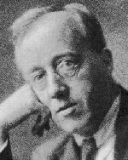
Click to enlarge
Other links which may be of interest - Holst Birthplace Museum , Full text of "In the Bleak Midwinter".
May I take this opportunity to wish all of you a merry Christmas and a happy new year. My e-mail address is organist@saintedmundschurch.org.uk. If you have any comments or questions I would be very pleased to hear from you.
November 30th - Advent Sunday
Prelude - O Come, O Come Emmanuel - C.Hand (1929-)
Postlude - Toccata - E.Gigout (1844-1925)
December 7th
Prelude - Advent Reflections - R.Bonighton (1946-)
Postlude - Nun Komm' Der Heiden Heiland (BWV 599) - J.S.Bach (1685-1750)
December 14th
Prelude - Gottes Sohn Ist komen (BWV 600) - J.S.Bach
Postlude - Sonata No 1 (First Movement) - J.S.Bach
December 21st (10.00am)
Prelude - Aria - S.Clark (1975-)
Postlude - Vom Himmel Hoch, Da Komm'Ich Her - J.Pachelbel (1653-1707)
December 21st (6.30pm)
Prelude - Les Bergers (La Nativité du Seigneur) - O.Messiaen (1908-1992)
Postlude - In Dulci Jubilo - J.S.Bach & Toccata - C.Widor (1844-1937)
FROM THE CONSOLE - NOVEMBER 2003
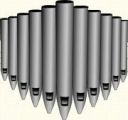
Click to enlarge
"From Advent to Trinity" is the title of my organ recital at St Edmund's on November 8th at 7.30pm. I shall be exploring music of the liturgical year and in my column this month I should like to give some brief details of my programme.
Johann Sebastian Bach's Toccata and Fugue in D Minor was composed in 1705 during his time as Chamber Musician and Court Organist to Duke Wilhelm Ernst at Weimar. In actual fact this work should be described as a toccata with a fugue in the middle (the word toccata is dervied from the Italian toccare, ``to touch'' and describes a composition that is intended to show off the performer's keyboard virtuosity). It is perhaps best-known in Leonard Stokowski's orchestral transcription in Walt Disney's Fantasia.
Like the Toccata and Fugue, Bach's "Orgelbuchlein" (Little Organ Book) also dates from his years at Weimar. It is a collection of 46 chorale preludes for the liturgical year designed as a teaching manual. He had planned to write 164 chorale preludes but never managed to complete the task. In my recital I shall be performing five of these pieces, written for Advent (Gottes Sohn Ist Kommen), Passiontide (O Mensch, bewein' dein' Sunde gross), Easter (Christ Lag in Todesbanden), Ascension (Heut' Triumphiret Gottes Sohn) and Pentecost (Komm, Gott, Schopfer, heiliger Geist). His setting of In Dulci Jubilo is based on a Christmas carol which first appeared in the 1582 Finnish collection "Piae Cantiones" and is always performed at the end of the Christmas Eve carol service at King's College, Cambridge.
The great Advent hymn O come, O Come Emmanuel, on which Colin Hand has based his composition, is based upon the seven Antiphons which were sung in the seven days preceding Christmas. The tune is first recorded in a 15th century Processional which belonged to French Franciscan nuns but is now in the Bibliothèque Nationale in Paris.
The Belgian twentieth-century composer Flor Peeters was organist at Saint Rombout Cathedral in Mechlin for over fifty years. His theme and five variations on King Jesus Hath a Garden dates from 1936 and is based on a well-known seventeenth-century Dutch carol. His chorale prelude on the Epiphany hymn "Stuttgart" (generally sung to the words "Bethlehem of Noblest Cities") dates from 1955 and is based on a melody by the 18th Century German composer Christian Witt.
Daughter of a Shepherd's Bush Market fishmonger, Betty Roe has a varied career as composer, performer, teacher and adjudicator. She has written over fifty works for organ including Coventry Carol. This carol depicting Herod's slaughter of the innocent children was named after the Pageant held in the Midlands town during the middle ages. This famous procession took place on the feast of Corpus Christi and consisted of performances from ten craft guilds covering the story of the world from Creation to Doomsday.
Malcolm Archer is Organist and Master of the Choristers at Wells Cathedral. His chorale prelude on the Epiphany hymn "Dix" which is sung to the epiphany hymn "As With Gladness Men Of Old" has a melody which was written by the nineteenth century German composer Conrad Kocher. The words were written by William Dix although unfortunately he did not like Kocher's tune, saying ‘I dislike it, but now nothing will displace it’.
Brahms only wrote fifteen works for organ, including the Eleven Chorale Preludes written in the final year of his life. The penultimate prelude, Herzlich Thut Mich Verlangen is based on a melody composed by Hans Leo Hassler better known as the Passion Chorale due to its appearance in Bach's Passions. In English it is often sung to the words "O Sacred Head, Surrounded".
Olivier Messiaen was one of the most original composers of the twentieth century. He was a deeply spiritual man and was organist at La Trinite in Paris for over sixty years. His music was influenced by non-traditional and non-western music systems as well as birdsong. L'Ascension, which he described as four symphonic meditations for organ, dates from 1934. I shall be playing the first movement, Majestie Du Christ Demandant Sa Gloire A Son Pere.
Giulio Caccini was one of the first composers of opera and bridged the renaissance and baroque eras. His song Ave Maria, which I shall perform in an arrangement by Noel Jones, has achieved remarkable popularity in the last few years and has been recorded by well known singers such as Andrea Bocelli and Lesley Garrett.
Charles Widor was organist of St Sulpice in Paris for 63 years and succeeded Cesar Franck as organ professor at the Paris Conservatoire. He wrote ten organ symphonies in total although he is now almost exclusively remembered for the famous Toccata which forms the fifth and final movement of the Fifth Symphony.
My layman's guide to the organ will continue in the December magazine.
November 2nd
Prelude - Chorale Prelude on "Stuttgart" - F.Peeters (1903-1986)
Postlude - Carillon Sortie - H.Mulet (1878-1967)
November 9th (10.00am)
Prelude - Nimrod - E.Elgar (1857-1934)
Postlude - Fame and Glory - A.Matt
November 9th (3.30pm)
Prelude - Pavane - G.Faure (1845-1924)
Postlude - Sicilienne - Maria Theresia von Paradis (1759-1824)
November 16th
Prelude - Pastorale - J.Lubbock
Postlude - Processional - William Mathias (1934-1992)
November 23rd
Prelude - Adagio for Strings - Samuel Barber (1910-1981)
Postlude - Prelude and Fugue in D Major - D.Buxtehude (1637-1707)
FROM THE CONSOLE - OCTOBER 2003

Click to enlarge
This is the first of my layman’s guides to the organ. You may have looked at the console in passing and wondered what all the knobs and switches were used for.
The first thing you will notice is that unlike the piano the organ at St Edmund's has three separate keyboards. These keyboards - or manuals - each have a different purpose. The middle manual - the Great organ - is the most important and contains the principal sounds of the instrument. The upper manual - the Swell organ - contains some of the softer sounds which are placed in an enclosed box. Unlike the other manuals these sounds can be made louder or softer through the use of a pedal (seen in the middle of the picture just above the pedals) which controls a shutter device on the side of the swell box. The clanking sound you can sometimes hear from the organ is this shutter opening and closing. This is the manual I generally use to accompany the choir. The lower manual is called the Choir organ and is a corruption of Chair organ. This was so-called because it was originally situated in its own separate case and placed behind the organist’s bench or chair in the organ gallery. It contains a number of different sounds as well as solo sounds such as clarinet and trumpet. The feet control the pedal organ which contains the lowest sounds on the organ. It is possible to play two manuals at the same time by using what are called couplers. If I use a coupler called Swell to Great then when I play the Great organ I am also simultaneously playing the swell organ.
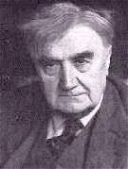
Click to enlarge
Ralph Vaughan Williams was born on October 12th 1872 at Down Ampney (immortalised in his 1906 hymn tune "Come down O Love Divine") in Gloucestershire. He studied at Cambridge University and the Royal College of Music (where he was later Professor of Composition), his teachers including Charles Wood, Charles Parry and Charles Stanford. Together with Gustav Holst, Vaughan Williams was one of the leaders of the 20th Century revival in English music and was greatly influenced by traditional English folksong which he spent a lot of time collecting. Vaughan Williams also studied in Paris with Maurice Ravel and his music also owes a lot to the Frenchman's impressionist style. His "Two Organ Preludes", which I am to play on the 131st anniversary of his birth, are based on traditional Welsh folk-songs and date from 1956.
October 5th
Prelude - Prière à Notre-Dame (Suite Gothique): Léon Boëllman (1862-1897)
Postlude - Toccata (Suite Gothique): Léon Boëllman
October 12th
Prelude - Romanza (The White Rock): Ralph Vaughan Williams (1872-1958)
Postlude - Toccata (St David's Day): Ralph Vaughan Williams
October 19th
Prelude - Sonata No 2 - Second Movement: Paul Hindemith (1885-1963)
Postlude - Sonata No 2 - First Movement: Paul Hindemith
October 26th
Prelude - Concerto No 2 in A Minor (BWV 593) - Second Movement: J.S.Bach (1685-1750)
Postlude - Concerto No 2 in A Minor (BWV 593) - First Movement: J.S.Bach
FROM THE CONSOLE - SEPTEMBER 2003
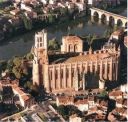
Click to enlarge
At the end of this holiday period I would like to share with you two remarkable churches and organs which I have visited during my trips to France over the past few years.
Albi is a city of some 50,000 inhabitants. It is located 50 miles to the North-East of Toulouse in the South-West corner of France. President Georges Pompidou and artist Henri Toulouse-Lautrec were both born there. The city is dominated by the impressive gothic Basilica of Sainte Cecile (pictured above). Built between the 13th and 15th centuries, it is the largest brick building in the world. Inside there is an amazing painted mural dating from the 15th century representing the Last Judgement. There are three levels - heaven, earth and hell. The organ originally dates from the 18th century and was built by Christophe Moucherel. It is generally considered one of the three finest in France.
The town of St Maximin is fairly close to my wife’s family home lying 30 miles to the East of Marseille in the heart of Provence. According to French legend, Mary Magdalene, together with Maximin, Lazarus and Martha, left Palestine by boat and landed in the South of France where she converted the region to Christianity and spent the rest of her days in a cave at nearby Sainte-Baume. It is said that she was transported to the chapel of St Maximin just before her death. The current St. Madeleine Basilica was constructed between the thirteen and sixteenth centuries although the crypt dates from the fifth century and is said to house the remains of four Saints including those of Mary Magdelene. The present organ was built by Jean-Esprit Isnard between 1772 and 1774. It has 4 manuals and 43 speaking stops. The current “Titulaire” (organist), Pierre Bardon, has held the post for over 40 years.
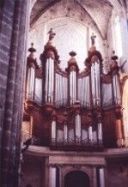
Click to enlarge
I will be giving an organ recital - From Advent to Trinity - at St Edmund’s Church on Saturday November 8th. The theme of the recital is the liturgical year and will include music by J.S.Bach (Toccata and Fugue in D Minor), Widor (Toccata from Symphony No 5) and Messiaen (music from “L’Ascension”). Please get in touch if you would like further information.
August 31st
Prelude - Canon in D - J.Pachelbel (1653-1707)
Postlude - Toccata in D Minor - J.S.Bach (1685-1750)
September 7th
Prelude - Ave Maria - Giulio Caccini (1545-1618)
Postlude - Toccata - Georgi Mushel (1909-1989)
September 14th
Prelude - Allegretto Grazioso (Six Organ Pieces) - Frank Bridge (1879-1941)
Postlude - Allegro Marziale (Six Organ Pieces) - Frank Bridge (1879-1941)
September 21st
Prelude - Choral (24 Pieces) - Louis Vierne (1870-1937)
Postlude - Arrival of the Queen of Sheba - George Handel (1695-1759)
September 28th
Prelude - Lied (24 Pieces) - Louis Vierne
Postlude - Chorale Prelude on Nun Danket - Siegfried Karg-Elert (1877-1933)





















